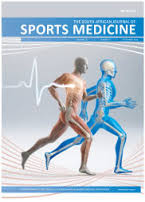The pattern of non-contact injuries in a South African professional football team
DOI:
https://doi.org/10.17159/2078-516X/2022/v34i1a13723Abstract
Background: The incidence, pattern and severity of non-contact injuries in European football has been researched extensively. In South African football only two studies have been conducted to date and with disparate outcomes. Further research into injury rates in South African football is therefore warranted.
Objectives: To determine the incidence and pattern of non-contact injuries in a South African professional football team during the course of a single season (2016-2017) in relation to competition exposure, training load and playing position.
Methods: Thirty-four male professional football players belonging to a single team competing in the Premier Soccer League (PSL) in South Africa were studied. Non-contact time-loss injuries (total training and match injuries) were recorded. Injury incidence, location, severity, type, and playing position (defender, midfielder, attackers, goalkeepers) during either match play or training were recorded.
Results: The non-contact incidence was 52 injuries with an injury rate of 3.74 per 1 000 exposures (training and competition). Competitions resulted in an incidence of 26.4 injuries per 1 000 exposure and training incidence 2.08 injuries per 1 000 exposures. Hamstring, groin and quadriceps injuries were the most frequently injured locations and muscle-tendon injuries accounted for the majority of injuries. The majority of injuries (52%) occurred during match play while 48% occurred during training. The greatest absolute number of injuries were sustained by midfielders (50%), followed by defenders (33%) and attackers (17%). However, relative to player numbers, the greatest number of injuries during match play were for defenders (44%), attackers (32%) and midfielders (24%). During training attackers sustained the most injuries (39%), followed by defenders (31%) and midfielders (30%). Goalkeepers did not sustain any non-contact injuries during the duration of the study.
Conclusion: The non-contact injury incidence in South African professional football players is similar to European football players. Hamstrings and groin injuries are predominant and were sustained throughout the competitive season. Defenders sustained the most non-contact injuries within the team relative to exposure time compared to attackers and midfielders. To our knowledge, injuries relative to player position have not been reported previously.
Downloads
Downloads
Published
Issue
Section
License
Copyright (c) 2022 South African Journal of Sports Medicine

This work is licensed under a Creative Commons Attribution 4.0 International License.
The South African Journal of Sports Medicine reserves copyright of the material published. The work is licensed under a Creative Commons Attribution 4.0 (CC BY 4.0) International License. Material submitted for publication in the South African Journal of Sports Medicine is accepted provided it has not been published elsewhere. The South African Journal of Sports Medicine does not hold itself responsible for statements made by the authors.
How to Cite
- Abstract 667
- PDF 566






.png)